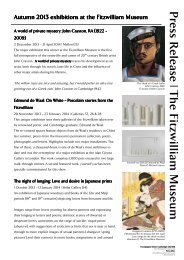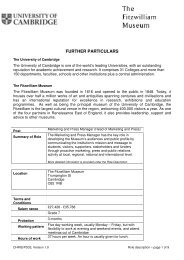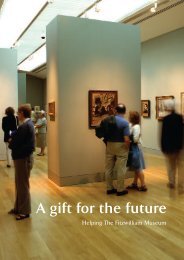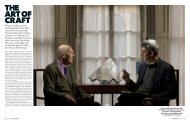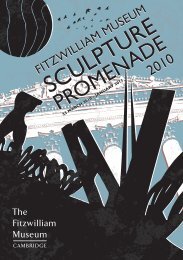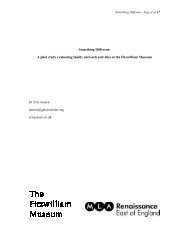Profile: Philip Grierson - The Fitzwilliam Museum
Profile: Philip Grierson - The Fitzwilliam Museum
Profile: Philip Grierson - The Fitzwilliam Museum
You also want an ePaper? Increase the reach of your titles
YUMPU automatically turns print PDFs into web optimized ePapers that Google loves.
<strong>Profile</strong>: <strong>Philip</strong> <strong>Grierson</strong>
Perry Hastings
<strong>Profile</strong>: <strong>Philip</strong> <strong>Grierson</strong> (1910-2006)<br />
“. . . the foremost medieval numismatist of our time, or indeed<br />
perhaps of any time.” Lord Stewartby<br />
<strong>Philip</strong> <strong>Grierson</strong>, medieval historian and numismatist, benefactor and the <strong>Fitzwilliam</strong> <strong>Museum</strong>’s<br />
Honorary Keeper of Coins since 1949, died on 15 January 2006, aged 95.<br />
In more than sixty years of avid collecting, Professor <strong>Grierson</strong> formed the most representative<br />
collection of the coinage of Continental medieval Europe that exists, which he has bequeathed to the<br />
<strong>Museum</strong>. A bachelor don, he remained a resident of his college – Gonville & Caius – for 76 years, yet<br />
he was acclaimed internationally, holding posts in Brussels and Washington simultaneously with those<br />
in Cambridge and receiving accolades from academies and learned societies around the world. He has<br />
been called ‘the foremost medieval numismatist of our time, or indeed perhaps of any time’. His life<br />
was one of contrasts – of stability and energy, of frugality and generosity, of erudition and frivolity.<br />
<strong>Philip</strong> <strong>Grierson</strong> was born in Dublin, and brought up<br />
in a Protestant family that had fallen on hard times<br />
as a result of the agricultural depressions of 1875-84<br />
and other circumstances. His father, <strong>Philip</strong> Henry<br />
<strong>Grierson</strong> (1859-1952), had been a land surveyor and<br />
a member of the Irish Land Commission, a post that<br />
he lost with the change of Government in 1906. As<br />
a result, he and his wife, Roberta Ellen Jane (1875-<br />
1970), moved to Clondalkin, near Dublin, to manage<br />
a small family farm and it was here that <strong>Philip</strong><br />
<strong>Grierson</strong> spent the first years of his life. His father,<br />
then in his 50s, acquired a reputation for financial<br />
acumen, and was appointed to the boards of several<br />
companies, establishing him in a new career which<br />
enabled them to leave the farm and move to the<br />
coast at Bray in 1914.<br />
He described his parents as ‘deeply and rather<br />
austerely religious’, and he and his two sisters – an<br />
elder brother had died in infancy – were never taken<br />
to the theatre and agreed to abstain from alcohol<br />
until they were 21. Although he later rejected the<br />
Christian faith, he admired and was very fond of his<br />
parents, and visited them regularly until his mother’s<br />
death in 1970. From the age of ten he was sent to<br />
boarding school, first locally in Bray, and then to<br />
Marlborough College, where he was very homesick.<br />
At school <strong>Philip</strong> <strong>Grierson</strong> was fascinated by science,<br />
and he resolved to become a doctor. In 1929 he was<br />
accepted by Caius to read medicine, but as soon as<br />
he came up he changed to history. He took a<br />
double first and was awarded the University’s<br />
25<br />
<strong>Profile</strong> – <strong>Philip</strong> <strong>Grierson</strong><br />
LEFT<br />
<strong>Philip</strong> <strong>Grierson</strong> on<br />
his father’s shoulders,<br />
c.1913<br />
FAR LEFT<br />
<strong>Philip</strong> <strong>Grierson</strong> in<br />
the <strong>Fitzwilliam</strong> Coin<br />
Room 2004
26<br />
<strong>Profile</strong> – <strong>Philip</strong> <strong>Grierson</strong><br />
Ramsey & Muspratt<br />
<strong>Philip</strong> <strong>Grierson</strong> as a young Fellow of Caius<br />
Lightfoot scholarship and the College’s top prize,<br />
the Schuldham Plate. In 1932 he began work as a<br />
research student on Carolingian history, but having<br />
been offered a Fellowship at Caius in his third year<br />
of research, as was the custom at that time, he<br />
thought it unnecessary to submit for a PhD.<br />
His early interest in science subsisted throughout his<br />
life, and later manifested itself in a taste for science<br />
fiction, and also for new technology. He enjoyed<br />
flying, and trained as a pilot in his early 20s, though<br />
curiously he never learnt to drive. On the evening<br />
of his admission as a Fellow of Caius in October<br />
1935, he left high table promptly so that a friend<br />
could fly him from Cambridge airport to drop him<br />
at Rugby where he could pick up the Post Train to<br />
Holyhead, to catch the ferry to Dublin and attend a<br />
family party the next day. He relished the challenge<br />
such a journey posed. He greatly enjoyed walking<br />
and on one occasion in 1932 or ’33, after seeing a<br />
play in London, he decided to walk home, arriving<br />
in Cambridge at lunchtime the next day. In 1934<br />
he walked the length of Hadrian’s Wall, returning<br />
to Cambridge riding pillion on a motorbike. He<br />
always took pride in his health and fitness, and,<br />
although not an avid sportsman, he regularly played<br />
squash as a way of both keeping fit and staying in<br />
contact with the young, continuing to play until his<br />
eightieth birthday.<br />
He was adventurous, and loved foreign travel – a<br />
taste he probably inherited from his father, who in<br />
the 1920s had travelled a lot in Europe, including<br />
Central Europe and the Balkans. In the long vacation<br />
of 1932, just after he had graduated, <strong>Philip</strong> <strong>Grierson</strong><br />
and a friend from Trinity joined a tour of Russia<br />
organised by Intourist, visiting Leningrad, Moscow,<br />
Rostov, Gorky, Stalingrad and Kiev. <strong>The</strong>re they left<br />
the party and headed south to Odessa, where they<br />
boarded a ship for Istanbul, and then wended their<br />
way back via Greece and Italy using a combination<br />
of ships, planes and trains. In a letter written home<br />
to his mother he reflects ‘the Ukraine and South<br />
Russia generally have imbibed far less of the pure<br />
milk of communism than Northern Russia, which<br />
makes it more pleasant to our eyes’. <strong>The</strong> following<br />
year he explored the Rhineland on foot, in 1936 he<br />
was in Finland and in 1937 he walked on glaciers in<br />
the mountains of central Norway.<br />
<strong>Philip</strong> <strong>Grierson</strong> later described himself as a ‘rather<br />
unpolitical person’, though he admitted that in the<br />
1920s and ’30s among students there had been a great<br />
deal of interest in foreign affairs, and in Russia in<br />
particular, as well as some sympathy for Germany<br />
which it was felt had been harshly treated in the Treaty<br />
of Versailles. <strong>The</strong> trip to Soviet Russia led him to collect<br />
books on the subject, which in 1943 he used as the<br />
basis for a well-received bibliography, Books on Soviet<br />
Russia, 1917-1942, followed by annual supplements<br />
until 1950. But ‘benevolent scepticism’ was the way he<br />
characterised his approach to life, and this might aptly<br />
describe his view of politics and the establishment.<br />
Six years after his Russian trip, he went on a far more<br />
daring venture. Five young Fellows of Caius – David<br />
Daube, Guy Griffith, Michael Oakeshott, Alec Parker<br />
and <strong>Philip</strong> <strong>Grierson</strong>, all of whom became Fellows of<br />
the British Academy – would play Mah-Jongg<br />
together as a group. David Daube, a German Jew<br />
who had come to Cambridge as a PhD student in<br />
1933, heard news that his father and father-in-law,
Medieval coins from the <strong>Grierson</strong> collection<br />
Jakob Daube and Hugo Aufseesser, had both been<br />
among the 30,000 Jewish men rounded up after<br />
Kristallnacht and they had been imprisoned in<br />
Dachau Concentration Camp on 11 November 1938.<br />
Daube wanted to get them out, and <strong>Philip</strong> <strong>Grierson</strong>,<br />
the only other member of the group who spoke<br />
German, volunteered to go over to negotiate on their<br />
behalf. He moved rapidly, obtaining a German visa on<br />
14 November, and armed with British entry permits for<br />
the families, expedited by the University’s MP Kenneth<br />
Pickthorn, he flew to Frankfurt on the 18th.During his<br />
few days there, he travelled to Freiburg (Daube’s home<br />
town), Basel (where there were family friends) and<br />
perhaps Munich (where the Aufseessers lived and close<br />
to Dachau), returning on 23 November. <strong>The</strong> men were<br />
released from Dachau on 20 and 26 November, and<br />
left with their wives to arrive in England where they<br />
lived into old age. Daube subsequently became Regius<br />
Professor of Civil Law in Oxford.<br />
At the outbreak of War <strong>Philip</strong> <strong>Grierson</strong> tried to enlist,<br />
but to his chagrin was turned down because of his<br />
eyesight and a childhood injury to his feet. He also<br />
failed an interview to work at Bletchley Park on the<br />
grounds that his German was not up to scratch!<br />
He, therefore, remained in Cambridge as one of a<br />
reduced team of dons teaching the History Tripos.<br />
He had already built a reputation as a medieval<br />
historian, and it was a chance event that kindled his<br />
interest in coinage. While spending Christmas 1944<br />
with his parents, he came across in his father’s desk<br />
a Byzantine bronze coin that intrigued him. He<br />
brought it back to Cambridge, and sought out<br />
Charles Seltman at Queens’ College, who identified<br />
it as a follis of the Byzantine emperor Phocas (602-<br />
10), and said that such coins were readily available in<br />
London. A week or two later, <strong>Philip</strong> <strong>Grierson</strong> visited<br />
Spinks, and said that he wished to buy a few<br />
medieval coins to show to his students and would<br />
spend up to £5, but he was ‘not a collector and had<br />
no intention of becoming one’. However, two weeks<br />
later he was back for more – the bug had bitten.<br />
By the end of 1945 he had bought over 1,500<br />
medieval coins and a year later his collection<br />
numbered some 3,500. He had come to the field<br />
at an unprecedented time, when the London dealers<br />
were awash with coins from the late Lord Grantley’s<br />
collection, sold in eleven auctions during the War.<br />
From this he was able to lay down the foundations<br />
27<br />
<strong>Profile</strong> – <strong>Philip</strong> <strong>Grierson</strong>
28<br />
<strong>Profile</strong> – <strong>Philip</strong> <strong>Grierson</strong><br />
for a systematic collection of Continental medieval<br />
coinage, which he then built on and developed over<br />
the next sixty years, and which eventually would<br />
number more than 20,000 coins.<br />
He realised that ‘medieval historians had not in<br />
general made nearly as much use of coins, either as<br />
illustrative matter or as first-hand evidence, as they<br />
might have done’. Initially, he saw his coins as<br />
supplementing his undergraduate teaching, a course<br />
of some 64 lectures covering ‘European’ history – the<br />
British Isles excepted – from 284 to 1492. Former<br />
students remember these lectures for the trays of<br />
coins he would pass around the crowded lecture<br />
theatre. But it was an invitation from Brussels in<br />
1947 to apply for their vacant Chair in Numismatics<br />
that prompted him to make this his main subject of<br />
research and publication. Fortunately the Cambridge<br />
and Brussels terms did not coincide, and for 33 years<br />
he managed his teaching load by spending part of<br />
the Christmas and Easter vacations in Brussels.<br />
He also impressed colleagues at the <strong>Fitzwilliam</strong>,<br />
and in 1949 Sydney Grose, the <strong>Museum</strong>’s Honorary<br />
Keeper of Coins intermittently since 1922, resigned<br />
the post in order that <strong>Philip</strong> <strong>Grierson</strong>, who was still<br />
only 38, might succeed him. It was a sound decision,<br />
for after 56 years <strong>Philip</strong> <strong>Grierson</strong> became the longest<br />
serving Honorary Keeper, and one of the <strong>Museum</strong>’s<br />
most outstanding benefactors, not only for his<br />
generous lifetime gifts and munificent bequest,<br />
but also for the support and advice he gave to the<br />
Coin Room staff.<br />
<strong>Philip</strong> <strong>Grierson</strong> had taken medieval numismatics by<br />
storm, and in just a few years he had become an<br />
authority in the field. Invitations poured in, to lecture<br />
in Europe and America, and to become the honorary<br />
‘adviser’ or curator for the coins at Dumbarton Oaks,<br />
Harvard’s institute for Byzantine research in<br />
Washington. His brief was to build the world’s finest<br />
collection of Byzantine coins and publish it. A task<br />
which by the time he relinquished that role in 1997<br />
he could proudly say he had achieved. Cambridge<br />
appointed him Reader, later Professor of Numismatics,<br />
and awarded him an Honorary doctorate, a distinction<br />
it rarely confers on its resident members.<br />
Despite his erudition and intellect, which at times<br />
could be intimidating, <strong>Philip</strong> <strong>Grierson</strong> was innately<br />
sociable and enjoyed a mischievous sense of humour.<br />
Professor Christopher Brooke recalled that in the<br />
1940s ‘We visited his rooms to read essays and to listen<br />
to his gramophone records and read his books: in a<br />
natural informal way his room was one of the most<br />
active social centres of the College.’ Later generations<br />
came to watch some of his 2,000 videos and DVDs.<br />
He had long had a reputation for being a film buff. As a<br />
student he was Secretary of the University Film Society,<br />
and when an eighth cinema opened in Cambridge the<br />
local newspaper could report: ‘Now Mr <strong>Grierson</strong> of<br />
Caius will be able to go to a different cinema every day,<br />
and two on Sundays’. Ever popular with students, on his<br />
ninety-fifth birthday, two months before his death, he<br />
gave a speech at dinner that was met with a rousing<br />
applause from the undergraduates. <strong>The</strong>ir respect and<br />
friendship he valued most of all.<br />
Mark Blackburn<br />
Keeper of Coins and Medals, University Reader in<br />
Numismatics and Monetary History, and President of<br />
the British Numismatic Society<br />
Sources<br />
‘Some memories: Interview with <strong>Philip</strong> <strong>Grierson</strong>’, <strong>The</strong> Caian 1978, pp. 33-55. 'A numismatic career: <strong>Philip</strong><br />
<strong>Grierson</strong> (1910-)', Numismatic Circular 99 (1991), pp. 223-4, 259-60, 291-2, 335-6; 100 (1992), pp. 3-4, 43.<br />
<strong>Grierson</strong> papers in the <strong>Fitzwilliam</strong> <strong>Museum</strong> and Gonville & Caius College Archives.



